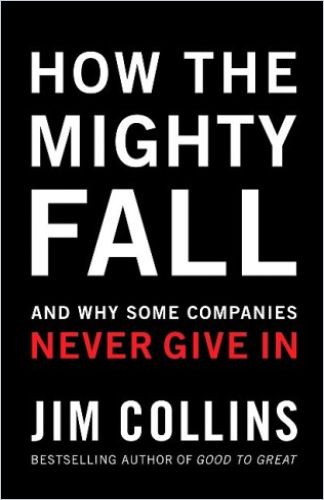This Jim Collins’ classic warns leaders about how things go wrong so they can prevent disaster.

Tracking – and avoiding – corporate decline.
Find a Diagnosis
The question “How would you know?” motivated Jim Collins, author of Good to Great and other business classics, to write this book. He first asked this question as the mystery of unexpected disaster struck his family when his apparently healthy wife was found to have cancer.
I began to think of decline as analogous to a disease, perhaps cancer, that can grow on the inside while you still look strong and healthy on the outside. It’s not a perfect analogy…organizational decline, unlike cancer, is largely self-inflictedJim Collins
This led him to compare corporate failure to “a staged disease” – hard to “detect,” but easier to cure in the beginning stages and much more difficult to stop later.
Why Companies Fail
Contending that failing companies go through “five stages of decline,” Collins draws on examples of several companies that once were riding high, but then made predictable errors and crashed. He describes these examples in varying detail, depending on how much room that description leaves for the true purpose of each chapter: to break down how his Five Stages of Decline manifest in actual case histories.
The mighty can fall, but they can often rise again.Jim Collins
Stages one to three seem to ignite Collins more than four and five. He allots less original thinking to the last two stages, perhaps because he regards them as more self-explanatory. Each chapter covers one or more doomed companies and delineates one of the five stages.
First: Hubris
Stage One of how companies fail is hubris, based on how well things have gone so far. Collins explains that successful large companies can fall victim to their own victories. “Momentum” blinds them to the long-term consequences of bad judgment or neglect. When corporate leaders believe their own hype, they forget they are successful because they have figured out why they do what they do.
The aim of this piece is to offer a research-grounded perspective of how decline can happen, even to those that appear invincible, so that leaders might have a better chance of avoiding their tragic fate.Jim Collins
The ancient Greeks first recognized and defined hubris as a surfeit “of pride.” Such pride always causes the arrogant hero to fail. Hubris is arrogance that manifests when companies strike out into fields in which they have no expertise or when they grow past their ability to “deliver with excellence.”
Collins cites Circuit City as an exemplar of hubris that failed in a “cycle of arrogant neglect.” Collins describes this cycle as: 1) You create a successful product; 2) you believe that novel business ideas will fuel success more effectively than your primary creation did; 3) you don’t keep improving your primary offering; 4) your novel offerings all take too long to prosper; and 5) by the time you re-focus on your primary offering, the company’s in trouble.
Second: Heedless Expansion
Collins and his researchers assumed that being complacent doomed most failed companies. To their surprise, this was seldom a major factor. Much more often, the problem at fault was the “undisciplined pursuit of more,” that is having a needlessly vast slate of new offerings that distracted a company from its core pursuits.
Even the mightiest of companies can self-destruct.Jim Collins
For example, Rubbermaid thrived until it launched 1,000 new products in a three-year period. At the same time, its costs for raw materials almost doubled in only 18 months. Rubbermaid could not recover, and was purchased by the Newell Corporation in 1998.
Companies that sow the seeds of their own destruction like this violate “Packard’s Law” – named for HP co-founder David Packard. He believed that companies were more likely to die from taking on too much than from a lagging core business. His law holds that no company can build revenues faster than it can bring in “the right people” to manage that growth.
Third: Denial
To illustrate the third reason companies fail – “denial of risk and peril” – Collins cites the familiar, tragic story of the explosion of the US space shuttle Challenger. The weather on the morning of its doomed launch brought temperatures well below those at which its crucial O-rings functioned best.
The O-rings sealed joints and kept gas from escaping. Leaders from NASA held a three-hour conference with engineers at Morton Thiokol, the O-ring producers. The engineers could not conclusively tell NASA not to launch, and the space agency may have pressured them to be optimistic. When the shuttle launched, the O-rings failed and escaping gases caused the fatal explosion.
Decline can be avoided. The seeds of decline can be detected early. And as long as you don’t fall all the way to the fifth stage, decline can be reversed.Jim Collins
When things go bad in the third stage of failure, corporate executives are likely to blame their subordinates, outside suppliers or unforeseen events. They won’t address the danger right before their eyes.
During this phase, companies often restructure. But that can generate a false sense that you are busy with activities that will make a difference. Collins says if reorganization is your main strategic defense, you’re in peril. Indicators that your company is in Stage Three include a culture that loses its sound “team dynamics,” minimizes or hides bad news, reaches for unlikely goals without the necessary research, and blames people or factors outside the company for the firm’s problems.
Fourth: Try Anything
As companies realize they’re foundering, they find themselves reaching out for any solution, even based on random hopes. They burn through their capital, create new offerings with little market research, seek mergers or acquisitions, or bring in a “savior” CEO.
Companies often mimic human panic behavior, reacting by doing exactly the opposite of what they should be doing at the moment. Just when companies must be at their most deliberate, thoughtful and strategic, they react emotionally. At these moments, those running a flailing company must, Collins says, “Breathe. Calm yourself. Think. Focus. Aim. Take one shot at a time.”
That’s what makes the process of decline so terrifying; it can sneak up on you, and then – seemingly all of a sudden – you’re in big trouble.Jim Collins
Indicators that your company is suffering from Stage Four behavior include seeking miracle cures in any form, touting a drastic shift, refusing to lower expectations realistically, going through brief periods of illusory success, experiencing increased cynicism in the office and suffering a gradual erosion of their fiscal foundation.
Fifth: Capitulation
At this point, nothing matters more than cash on hand. Companies can show profits and still “go bankrupt.” Even companies with sound earnings can fail if they don’t have enough cash. As the death spiral moves from stage to stage, dying companies find themselves with diminishing cash and collapsing options. One day, they simply don’t have enough to go on, and they capitulate.
“Never give in.”
Collins cites UK Prime Minister Winston Churchill as a laudable example of perseverance. Disgraced after several disastrous tactical decisions during World War I, Churchill lost most of his wealth in the 1929 stock market crash. Shortly after, he suffered long-lasting injuries and depression after a car accident.
If some of the greatest companies in history can collapse from iconic to irrelevant, what might we learn by studying their demise, and how can others avoid their fate?Jim Collins
In the mid-1930s, the English power elite regarded Churchill as a relic of the past. But when a Nazi invasion threatened Britain in World War II, the nation called on Churchill to lead. He rallied his country with the thundering call: “We will never surrender.” Collins points to Churchill’s determination to never give in as a role model.
Stick to Your Principles
That is the sum of Collins’ advice: Diagnose your real situation. Never give in. Watch out for the five steps of decline, and never stray from your purpose. Accept that some ventures fail. Close large operations if they’re not generating profits – but never “give up on the principles that define your culture.”
Across his bestsellers, Collins is always a consistent advocate of hewing to your values, being thoroughly informed and being realistic about your organization’s situation. His explanations are so steady and, by now, so familiar that it’s easy to forget that his insights were often groundbreaking when first published. His clarity, good sense and knowledge hold up reliably over time, even as the companies he writes about rise and fall, and sometimes rise again.
Jim Collins is also the author of Good to Great: Why Some Companies Make the Leap…and Others Don’t; BE 2.0 (Beyond Entrepreneurship 2.0): Turning Your Business into an Enduring Great Company; and Turning the Flywheel: A Monograph to Accompany Good to Great. He also wrote Built to Last: Successful Habits of Visionary Companies with Jerry I. Porras and Great By Choice: Uncertainty, Chaos, and Luck – Why Some Thrive Despite Them All with Morten T. Hansen.













